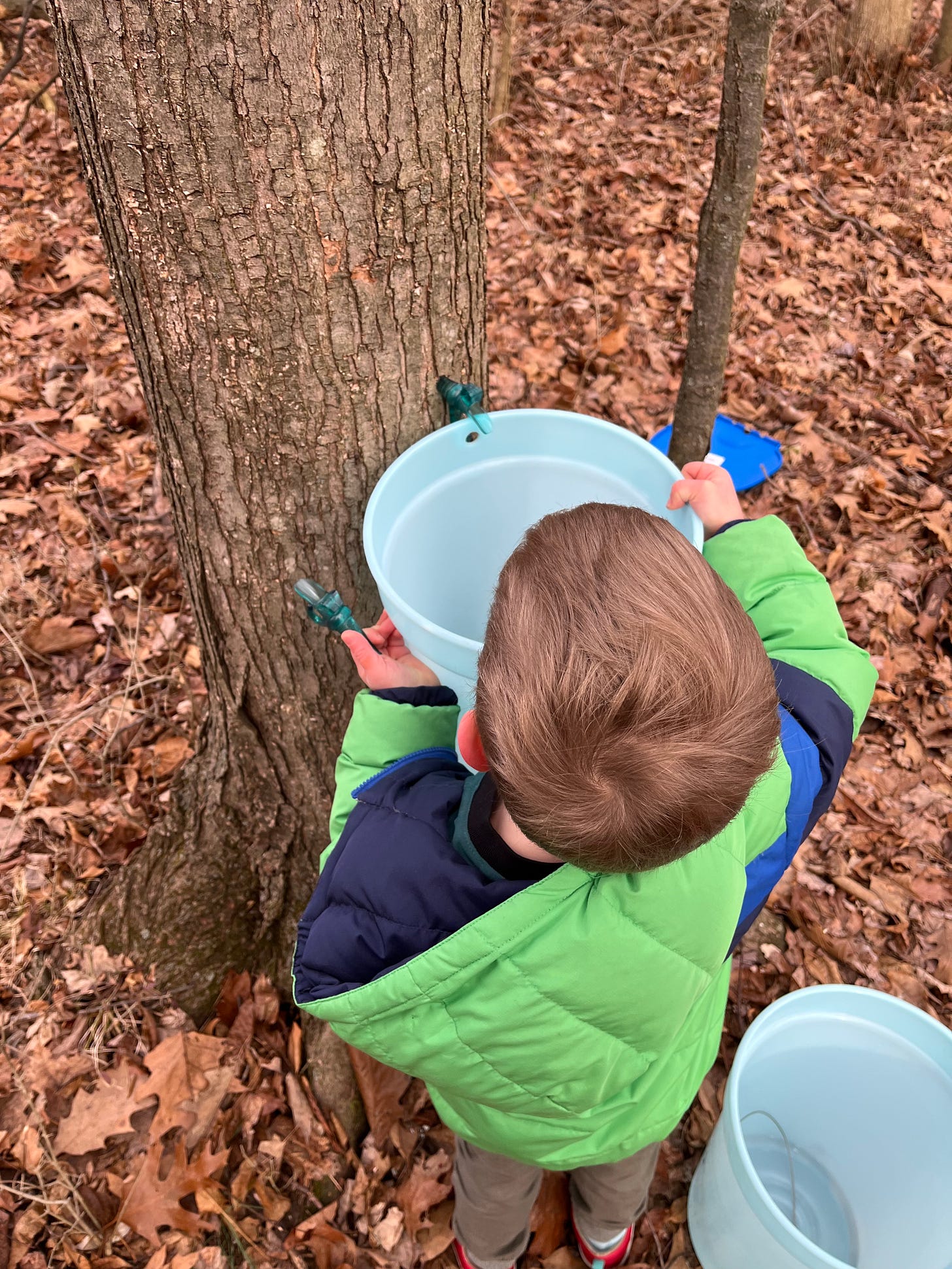How sugaring feeds my soul
A natural and cultural history of maple syrup in America
This essay first appeared in Fourth Genre under the title “Syruping” in 2020. I expect to include some version of it in my fatherhood memoir (yet in progress), but as you’ll see I now need to reframe my discussion of Iowa and include more of my children. My second season of sugaring in Pennsylvania is now underway. We’ve expanded to four trees and expect a decent harvest, even though the season is alarmingly early. My middle daughter and my son helped me tap the trees this year, and I hope the ritual will become part of their sense memory. But even my eldest, who claimed she “did not care” about sugaring this spring is not above taking a whiff of sugary steam when I am boiling on the patio. I am confident that the story is still safe in her foundational memories.
Every spring in southern Iowa between late February and March, the thaw hits a sweet spot that sends sugar makers out into the trees. Farther north, syruping traditionally begins in March, when the full moon is known as the Sugar Moon. But no matter the date, the signs of sugar season are the same. When a light frost falls overnight and sun warms the ground above freezing, the sap starts running. All anyone needs to catch it is a drill and a bucket. Then, like magic, the sap turns to sugar over a fire. It is nearly as close as we can get to a place: eating sugar straight from the tree.
Before there was sugar making, the Anishinaabe say, in the time after Nanabush created the world, hunting was easy, the weather was good, and thick syrup flowed straight from the maple trees every day of the year. But one morning Nanabush discovered that his people had abandoned their gardens, fishing nets, and firewood gathering and were instead lying throughout the forest catching syrup from the branches with their open mouths. Fearing they would grow ungrateful and forget their ceremonies, Nanabush ran to the river with a birch bark bucket and carried water over the forest canopy, pouring it down the tops of the maple trees. From then on, he said, sugar making would be hard. The sap would only run for a season. The people would have to gather wood for fires and heat stones to boil the sap down to syrup. It would take a long time, but after all of this work the people would appreciate what they had been given.
Little about syruping, other than its origins in subsistence living, is native to Iowa. The tradition is an import from the north, just as I am. The Meskwaki people, who practiced sugar making in the Great Lakes region, brought syruping to what is now Iowa in the eighteenth century as they migrated south, following stands of hard maples near the Mississippi River. Maple syrup remains an important part of food sovereignty initiatives at the Meskwaki Settlement in central Iowa. But the practice was likely unknown to other First Nations here, such as the Sioux and Ioway, who centered their identity and subsistence on grassland cultures. In much of what is now farmland in Iowa, the maple tree was one of the “rear guard species” that Aldo Leopold describes as following the bur oak army south in the battle between woodland and prairie. Huge fires, fueled by dried grasses and prairie plants like Silphium, which can grow fifteen feet high, made the woodland-grassland war a standoff for tens of thousands of years until the settler’s plough cut through the fire’s path. My own Norway maple is no more than sixty years old, maybe three generations removed from the makeover of tallgrass into wooded farms. Some might say that my tree is a northern invader and that I and my sugar making are, as well. A more generous view might be Thomas Dean’s reminder that the prairie was once an inland sea, that the “permanent is elusive, a phantom,” that when we “reach through the long past for a sense of permanence,...what we grasp is change.” I want to see my own syruping as a touchstone for the way a place changes, the way all places are now changing. Syrup itself is changed, from rain and soil into sap, then back into steam and the sugar left behind.
Syruping is one of hundreds of ways to track the seasons, most of which I know best through food. Syrup means spring, the way tomatoes mean summer, apples mean fall, and Brussels sprouts sweetened by frost say winter is near at hand. Syruping, like seed saving or home brewing, also opens up community. My friend Paul, who taught me about soil horizons, was the first to show me how to harvest syrup from my maple tree. Paul brought his hand drill to my place one morning when the grass was brushed by frost and loaned me a spile and a steel bucket with a cover to keep out debris. Ever since it has been a yearly conversation between us — when we think the sap might run, when we think the sugar window is closing. Some might see it as little more than elevator talk, but anyone who has tapped a tree, listened to the sap drum in the pail, and then watched it boil down into a pint of gold will want to tell that story again.
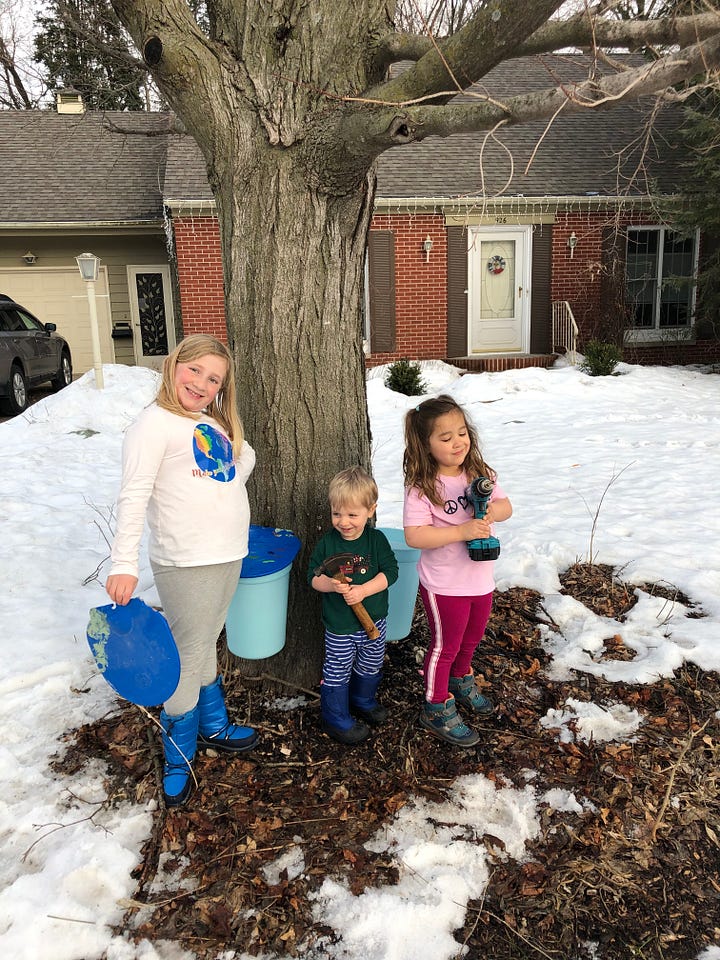
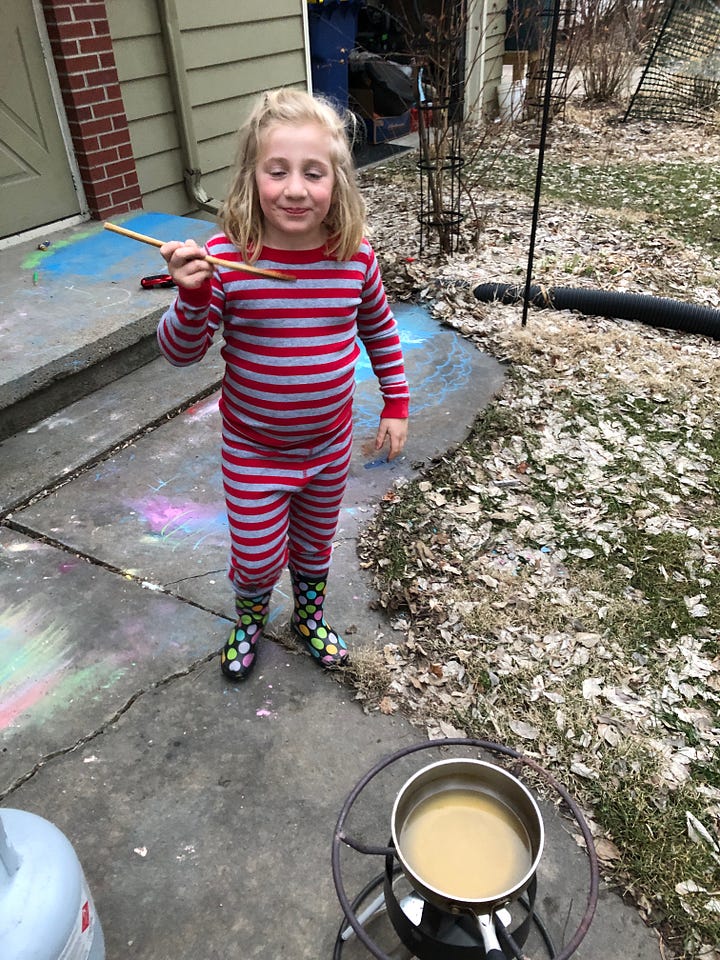
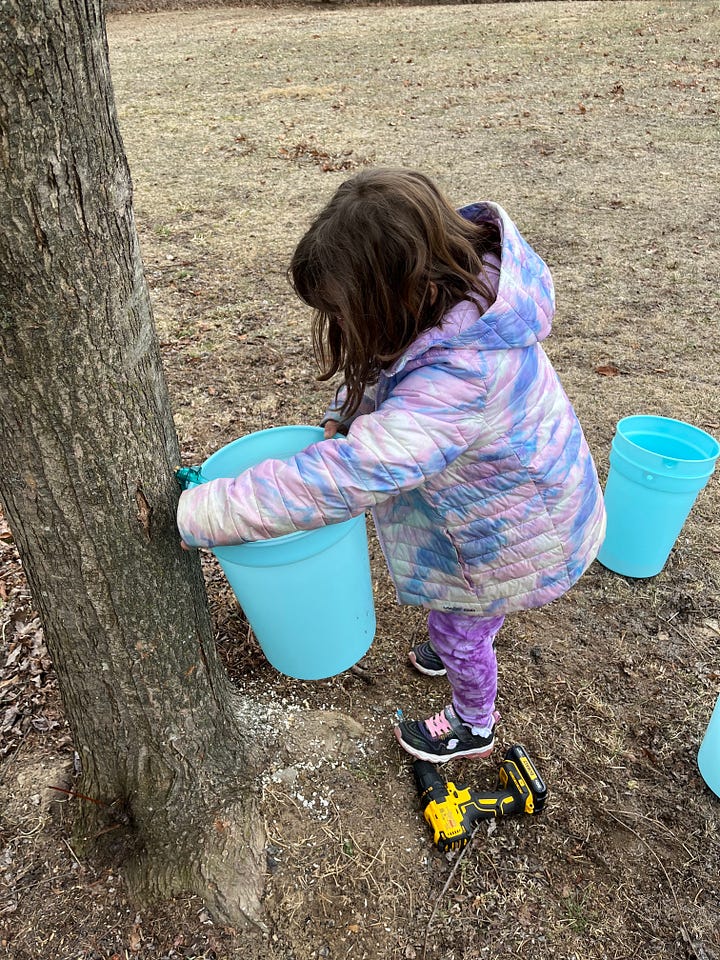
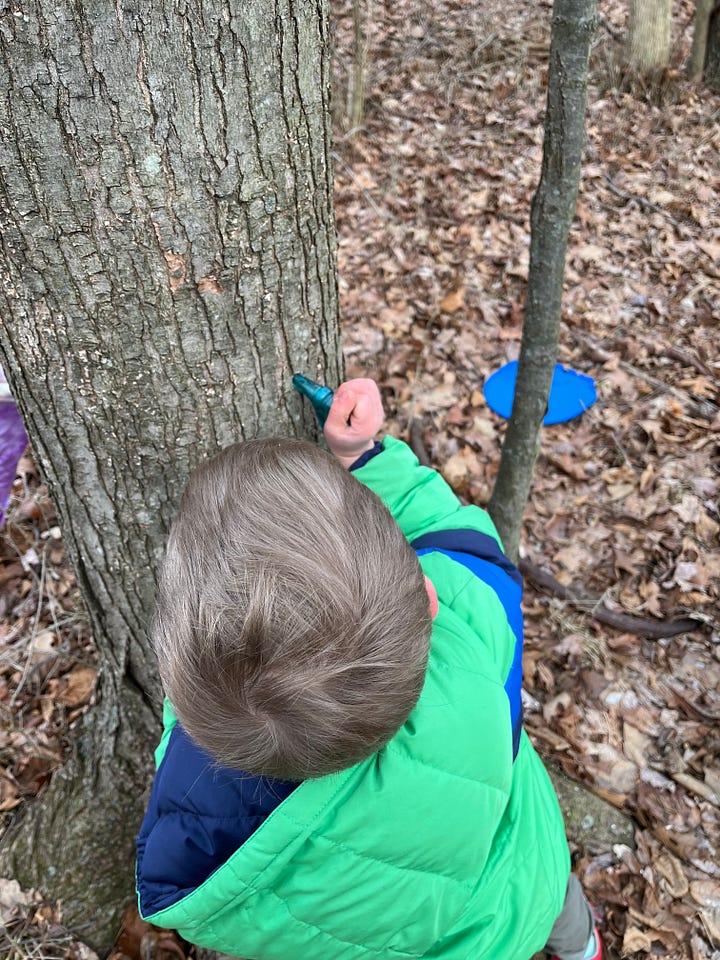
When I am sitting with my family on a Saturday morning and we are passing the syrup jar and my daughter says, earnestly, “Thank you, Maple Tree,” the moment feels as real as any of our traditions. But I am also struck by the lightness of it, how close it could be to a vacation souvenir or a Disney character in one of her favorite shows or a plastic toy that thrills until it doesn’t. Yet that might be the best place for syruping to live in her imagination, the borderland of story that merges the mythical with the real. I watch her lose herself in a sugary stack of pancakes, morning sunlight in her hair, and I know that she is moving between worlds the way I wish I still could. If the pint jar on the table can become the cover of a book to her instead of just sap from the tree, it has real potential to drop a lasting anchor in her memory.
I imagine my daughter leaving home for a college dorm, decorating a cell of concrete blocks as if she belongs there, then clearing it in the spring and doing it all over again in the fall, how this ritual of settling and erasure will come to feel (after four years or more) as real as anything else in her sense memory. It is the ritual I have been trying to break over the past decade of making a home in a place where I had no roots. Restless settlers might have brought the maple tree to me, but the craft of syruping, like gardening or canoeing or cycling the back roads, has been one of my antidotes to placelessness, the kind of touchstone I hope my daughter might also recall later in life when she needs reminders of who she is. I feel within myself the urge of self making and remaking that will become her own, how she will need to assemble a shape, a theme, an arc from her story-rich past. The choice will be hers then. Syruping could be just a bucket on a tree, talking about the weather, no big deal. Or it could be the miracle of a maple drawing its lifeblood from water and dirt, starting an alchemy that finishes over her fire and ultimately within her, sweetness on her tongue, sugar in her blood, the fuel of thought itself.
Anishinaabe people tell another story about Nanabush. He was standing in the forest when it began to rain syrup. Nanabush made a birchbark vessel to catch the syrup, but he thought it would be too easy for his people to just gather their sugar from the sky. They would need to hold a ceremony, say prayers, and make a gift of tobacco to show respect. Then he learned from his grandmother that syrup would flow right from the maple tree. So he drenched the forest with rain to water down the syrup. The lesson in both stories is the same: people must labor and wait for their food to observe a balanced lifeway.
Whether it was Nanabush or the creative energy of evolution that buried syrup’s secret in the maple tree, I am grateful that it takes effort to work that magic now. The work is a chance to remember, to give thanks, the way I think of sunlight while enjoying the warmth of a wood fire, how eighty, ninety, a hundred years of solar heat can be stored in hickory or oak, then released in an hour or two by a flame.
The next section explains how maple sugaring became part of American identity after European settlement and how a tradition that has remained virtually unchanged since colonial times is threatened by new methods that would turn maple saplings into a row crop.


